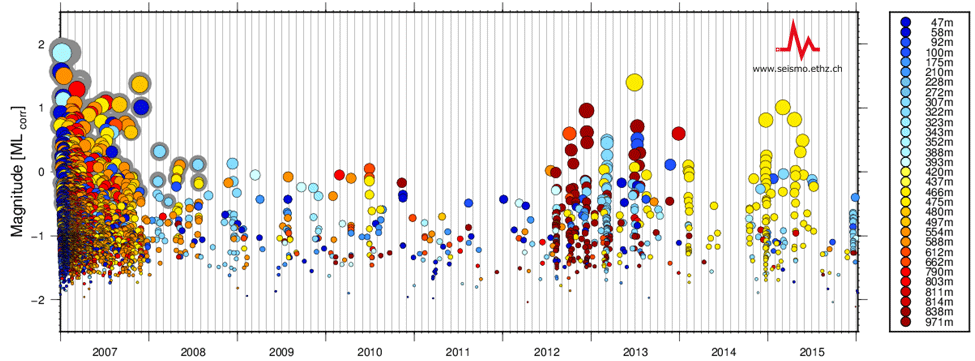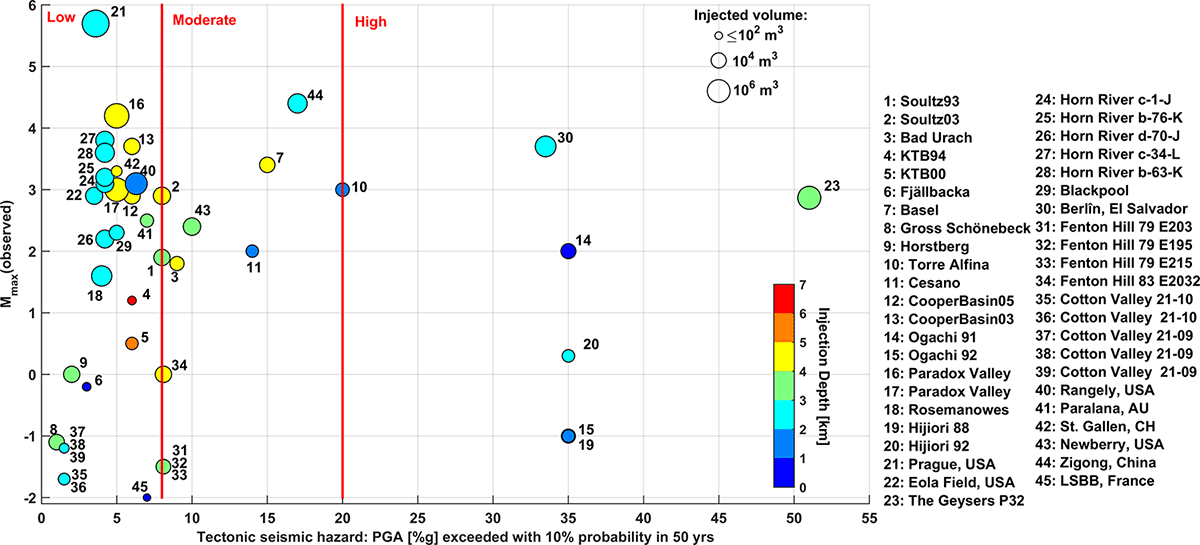Geothermal Energy and Induced Earthquakes
Induced Earthquakes Basel

Switzerland is located in a tectonically active region. The Swiss Seismological Service (SED) records between 1'000 and 1'500 earthquakes every year, of which 10 to 20 are typically noticed by the public. However, not all of these vibrations are of natural origin – some are triggered by human activity. In this case, science speaks of "induced earthquakes" or "induced seismicity". Induced, man-made earthquakes are, in principle, just like any other earthquake. These too are the result of a sudden release of tension along fractures in the earth’s crust. The seismic energy released by this movement spreads though the earth and along the earth’s crust in the form of waves, causing the vibrations that we experience as earthquakes. Induced earthquakes cannot be distinguished from natural ones on the basis of their physical characteristics.
Induced seismicity is often caused by major technological interventions in the subsoil. Man-made earthquakes were already observed over 100 years ago in connection with coal mining in Germany and the UK, for example. With few exceptions, these earthquakes are very small and are unnoticeable or hardly noticeable on the surface. Worldwide, induced earthquakes have caused significant economic damage in some cases but have resulted in few injuries and even fewer or no deaths. An overview of induced earthquakes worldwide can be found in the Snapshot "Man-Made Earthquakes". In Switzerland, man-made earthquakes are related mainly to geothermal energy projects. In 2006, an earthquake in Basel with a magnitude of 3.4 was triggered by water being injected at high pressure into the ground, and an earthquake with a magnitude of 3.5 occurred near St. Gallen in 2013. Induced earthquakes have, however, also been observed in Switzerland in connection with the construction of tunnels and dams.
The induced seismicity associated with international geothermal energy projects, as well as those in Basel (2006) and St. Gallen (2013), is thus a major challenge. The focus is therefore on the question of how the necessary rock permeability for a functioning geothermal energy project can be created without causing strong vibrations.
Factors that Influence Induced Seismicity
Various factors influence the frequency at which induced earthquakes occur in connection with a geothermal energy project.
The larger the volume of rock is affected by stress changes, the more events are likely to happen. This is a first-order geometrical effect. Whether maximum possible event size also scales with the affected volume or fault area is currently a debated issue (Baisch et al., 2010a; Gischig and Wiemer, 2013; McGarr, 2014).
In an ideal closed system, the operation will reach a steady-state and pore pressure changes remain confined to a certain volume. Seismicity in such systems should level off with time (i.e., Soultz). In open systems, the pressure or strain footprint is growing with time, and seismicity in such settings will be more variable, sudden increases are possible when critically stressed patches are reached by the pressure/strain changes. Seismicity in such settings can be sporadic (i.e., Landau), increasing with time (Groningen Gas Field) or more or less steady (Paradox Valley).
Deeper systems are generally believed to produce more induced earthquakes, a consequence of the strength profile of the earth crust: Differential stresses will increase with depth, natural earthquakes are likewise less frequent in the top 1−3 kilometers of the earth’s crust. Modeling suggests that the increase in seismogenic response due to the increase will overcome the geometrical effect of the decay in Stefan Hirschberg et al., Energy from the Earth © vdf Hochschulverlag 2015 WP5: Risks 269 ground motions with distance (Gischig and Wiemer, 2013), however there is so far surprisingly little empirical evidence for the depth dependence.
Crystalline basement rocks are typically believed to be more seismogenic than sedimentary rocks (Evans, et al., 2012).
The assumption that areas of lower natural seismicity also are areas less likely to respond with high levels of induced seismicity, or with lower maximum magnitudes is intuitive. Evans et al. (2012) suggested, based on a European database, that indeed areas with lower background hazards (defined arbitrarily as peak ground acceleration (PGA) values < 0.08) also have lower maximum observed magnitudes. To investigate this potentially important relation further, we have updated the Evans et al. (2012) database, adding data from outside of Europe. As seen in Figure 114, these additional data suggest that the hypothesis of low PGA regions producing lower maximum magnitude events can be rejected.

Figure 114: Scaling between the expected maximum observed magnitude and the local Peak Ground Acceleration (PGA, in percent of gravity) with 10 % probability of being exceeded in 50 years (derived from the Global Seismic Hazard Map). The dataset is expanded from Evans et al. (2012). Markers are colored according to injection depth and have sizes corresponding the injected volume.
In general, the higher the (differential) pore pressure changes the underground is subjected to, and the more rapid these changes, the more likely are induced events. Seismicity often starts only once the pressure changes have exceeded a certain minimum threshold. On the other hand, it is known that faults very close to failure can be triggered by very small pore pressure changes (e.g. Rothert et al., 2003).
Injections near known active fault systems greatly enhance the chance of inducing earthquakes. For some applications, such as waste-water disposal, the rule of thumb therefore is ‘stay away from active faults’ (Zoback et al., 2012).
The in-situ stress clearly plays an important role in determining the seismogenic response of the underground. Pre-existing differential stress on a pre-existing fault is a pre-requisite for inducing hydroshearing events. In areas where the stress conditions are very close to lithostatic (σ1 ≈ σ2 ≈ σ 3), inducing larger earthquakes is much less likely. Likewise, the complexity and heterogeneity of the stress field and the fracture network is important, but often poorly known before drilling.
Areas where the relative earthquake size distribution of natural earthquakes (the b-value of the Gutenberg-Richter law) is shifted towards high values (b > 1) may also produce fewer larger induced events and more small ones. Gischig et al. (in preparation) suggest that these may be favorable conditions for creating a geothermal reservoir with acceptable seismic hazard. Volcanic or geothermal regions, such as the GEISER (Geothermal Engineering Integrating Mitigation of Induced Seismicity in Reservoirs), Taupo or parts of Iceland, are typically characterized by high b-values, and shallower reservoirs at lower differential stresses, which may explain why these have had fewer problems with induced earthquakes despite having been in production for many years.
Potentially damaging events are less likely to occur when traffic light systems are set conservatively. This means, interruption thresholds are set lower and injections therefore are interrupted earlier. However, more conservative traffic lights will have a strong impact on the commercial success rate of the projects.